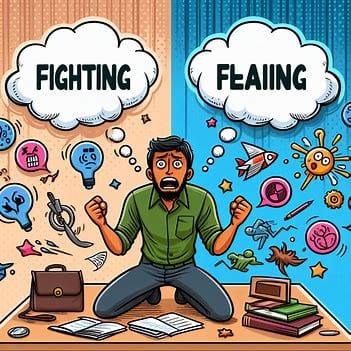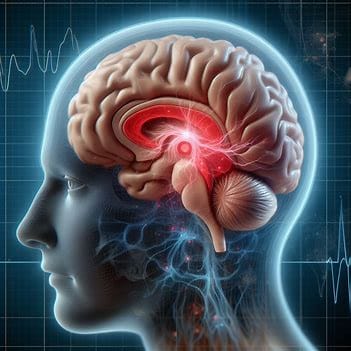All of us can attest to having felt scared sometime or the other in our life. It could have been fear of the doctor's needle when we were little children or the fear of public speaking in our youth or else the fear of losing your job once you are in married life. Whatever be the case, the emotion of fear is universal and primal to all humankind. The problem arises when it becomes illogical and disproportionate to the threat.

Is Fear an Internal or External Influence?
Irrational fear can manifest in various forms. Someone fears spiders, someone else is fearing closed spaces, others are fearing the lizards, snakes, etc.
Examples from history, such as the excessive panic surrounding cholera in the 15th century, highlight the deadly consequences of unregulated fear. In this instance, people succumbed not directly to the disease, but rather to their own fear of it.

In one Guru’s ashram, a mouse came to stay. Guru ji realized the mouse used to fear the cat, which would sometimes visit. So, by his spiritual powers, he changed the mouse into a cat. Now it started fearing the dog. So, Guru ji transformed it into a dog, but then it became scared of the mountain lion nearby.
The Guru said, "This is not the solution."
He transformed it back into a mouse and said, "We'll have to bring about a change from inside to become fearless, a change in the mind."
The Science Behind Fear
The brain has different parts and lobes, including the neocortex and the prefrontal cortex, which are responsible for rational and logical thinking.
The Amygdala is a small almond shaped structure in the temporal lobe of the brain close to the ears, size of a shelled peanut. Amygdala exists as a paired structure, one each in the left and right hemisphere of the brain.
Amygdala acts as brain's primary threat detector, constantly scanning and
evaluating incoming sensory information for potential danger.
The context of fear makes the amygdala secrete epinephrine and cortisol, which then captures the neocortex and the prefrontal lobes. They realize the fear is irrational, but they are unable to do anything because the amygdala takes charge.

This phenomenon is called, in scientific terms, the amygdala hijack. It puts the body in a high-stress situation where the blood is diverted from the organs into the muscles, the heart starts pounding, one breaks into sweat, and the attention is riveted on the object of the threat. All this to help in two actions: either fight the threat or, if it is too big, then take flight.
Root Cause of Fear – The Ancient Vedic Perspective
The Vedic scriptures relate fear with human tendency of attachment to object, outcomes, situations, etc. They inform us that fear is not an affliction; it is the symptom of an affliction, just like if one catches malaria, the symptom will be fever. While fever can be suppressed by taking medicine, but the malaria pathogens will remain. Likewise, fear is only the symptom, and the actual disease is attachment.
Sage Bhartrihari stated, "If you are attached to sensual enjoyment, you will fear disease. If you are attached to a high position, you will dread downfall. If you are attached to wealth, you will dread penury. No matter where your mind clings, you will experience fear."
If we wish to become fearless, we will need to get rid of attachment itself.
In the Bhagavad-Gita, Lord Krishna too emphasizes that attachment generates fear.

वीतरागभयक्रोधा मन्मया मामुपाश्रिता: |बहवो ज्ञानतपसा पूता मद्भावमागता: || 10||
vīta-rāga-bhaya-krodhā man-mayā mām upāśhritāḥ
bahavo jñāna-tapasā pūtā mad-bhāvam āgatāḥ
….Actually, attachment is the cause of both fear and anger. Fear arises out of apprehension that the object of our attachment will be snatched away from us. And anger arises when there is an obstruction in attaining the object of our attachment. Attachment is thus the root cause of the mind getting dirty….
Read full commentary of this verse in the Bhagavad Gita commentary by Swami Mukundananda.
So, the ancient Vedic wisdom clearly states that the root cause of fear is attachment. This could be to bodily comfort, to a material situation, or to a person. Our mind clings to the subject of its attachment and fears separation from it. The way to become fearless then is to practice detachment.
Impacts of Sustained Fear on Physical and Mental Health
Fear not only affects us mentally but also has physiological effects on our body. When we experience fear, our body goes into a fight-or-flight response, releasing stress hormones like adrenaline and cortisol. This response prepares us to either confront the threat or escape from it.
Physiological effects of fear can include increased heart rate, rapid breathing, sweating, and muscle tension. Prolonged exposure to fear can weaken our immune system, disrupt sleep patterns, and negatively impact our overall well-being.
On a psychological level, fear can lead to chronic anxiety, low self-esteem, and a sense of helplessness. It can also limit our ability to think clearly and make rational decisions.
Even though fear is an essential part of keeping us safe, when people live in constant fear, whether from physical dangers in their environment or threats they perceive, they can experience negative impacts in all areas of their lives. Recognizing these consequences encourages us to actively train our minds to become fearless
Tools and Techniques to Become Fearless
Fear is just an emotion. Becoming Fearless is not the absence of fear but the mastery over it. Lets analyze from this example.
A king in ancient times feared his enemies so much he fortified his palace and built a strong room for himself where there was only a little window for interacting with the world.
A sadhu appeared one day for alms and was permitted to speak to the king through the window. "Why do you stay like this?" asked the sadhu.
The king responded, "It is because I fear my enemies could kill me any time,"
"But your majesty," responded the sadhu, "you are already dead."
"How is that?" said the king.
"You are living in a tomb except that you have a little window through which you interact."
After having understood the nature of fear, let’s delve into some of the ways we can become fearless.
Gather facts about the object of your fear. When we gather information about the situation, it often diminishes any irrational fear we may have and help us become fearless.
One bus conductor was having a normal day until a huge 6 feet hulk boarded the bus at the next stop. When asked for the fare, the man simply said, "Bajrangi Pahlwan does not need to pay." The conductor, a diminutive himself, stayed quiet. This happened every day. The man would say, "Bajrangi Pahlwan does not need to pay." Irked by this, the conductor went to the gym, trained himself, and equipped himself with weapons. Then, he gathered his courage and asked for the fare again. The man replied, "Bajrangi Pahlwan does not need to pay."
The conductor asked why, and the man revealed he had a bus pass. So, the conductor was fearing unnecessarily.

Similarly, Many people dread flying, but if they learn that the chances of dying in a plane crash are much smaller than those of dying in a car accident, their fear will likely subside.
Consider the worst-case scenario. For certain situations, envisioning the worst-case scenario can help us recognize potential issues and find their solutions. If we feel prepared to deal with the situation, we will obviously become fearless.
For example: If you are dreading losing bodily comfort, ask yourself what the worst situation would be. If you can make peace with the worst-case scenario, you will realize it is not as bad as you imagined and you will gain control over your fear.
Systematic desensitization. This technique involves exposing yourself to the object or situation of your fear in a progressively increasing fashion. For example, if someone is fearful of public speaking, bring them up before the group for just one minute on the first day and then for two minutes after a few days and then for five minutes. Slowly they learn to get desensitized to the situation that they were fearing.
Living in the present. Mastering the art of living in the present takes dedicated practice. It does not imply completely dismissing both the past and the future. Reflect on the past, but don't dwell on it; focus on the present; and plan for the future without worrying about what it holds. When present-moment awareness is combined with other fear-reduction techniques like desensitization, the results can be even more impactful.
Develop love for God to become fearless. The culmination of the journey towards fearlessness is found in complete surrender to the divine. Recognizing oneself as a child of the Supreme Divine, entrusting all fears and concerns into the hands of a caring, omnipotent force, ensures that fear has no place to reside. This spiritual surrender, coupled with the practice of detachment, reveals that true security and peace are not found in the external world but within the sanctuary of faith in the divine.

The narrative of Angad's encounter with Ravana in the epic Ramayana, is a great example of fearlessness derived from having deep love for God. Angad's confidence and bold actions were born out of his deep-seated belief in Lord Rama's protection.
What enabled such fearlessness in Angad? It was his surrender to the Supreme Lord Rama and for enabling that kind of surrender, the first step is detachment. The proposed mantra is - Give it your all, without being attached to a particular outcome.
Read detailed account of Angad’s encounter with Ravana in the city made of gold, Lanka.
Self-Care. Finally, attending to your physical well-being can effectively address the physical symptoms associated with fear and anxiety. This means you need to prioritize getting adequate sleep, consuming a well-balanced diet, and regularly engaging in physical activity.
In Conclusion, It is critical to recognize that fear is a manageable emotion. By understanding the mechanisms of fear and adopting practical strategies to mitigate its impact, we can become fearless. Living in the present, planning for the worst-case scenario, getting equipped with knowledge, and desensitization via slow exposure are some of ways that can all help reduce fear's hold over our brains and lives. Most importantly, we must cultivate detachment as prescribed by ancient Vedic wisdom. Ultimately if we can surrender to the Lotus feet of God, all fear will vanish because he is the protective Divine Father and we are his little children.
FAQs on How to Become Fearless
Can fearlessness be learned?
Yes, fearlessness can be cultivated through practice, mindfulness, and spiritual discipline. It requires both a cognitive understanding of fear's nature and developing faith in the protection of God.
Will detachment To results cause a decrease in my performance?
Let's get answer to this from Swami Mukundananda in this short video here.
How can I start practicing detachment?
We can start off by developing love for God. Swami Mukundananda has beautifully answered this question in this Facebook post.
What if my fear does not go away despite my efforts?
Persistent fear, especially when it interferes with daily functioning, may require professional support. Simultaneously, continue your spiritual practices with patience. Retraining the mind requires deliberate efforts over a period of time. There will be ups and downs on this journey of self improvement.
Joining free online classes offered by JKYog can help speed up the transformative process – https://www.jkyog.org/online_events
What if my faith wavers during challenging times?
It's normal for faith to fluctuate. During such times, remind yourself of past instances when you felt supported or guided. Spiritual practices like meditation, prayer, chanting Hanuman Chalisa or Vishnu Sahasranamam and reading the Holy Bhagavad Gita commentary by Swami Mukundananda daily can also strengthen faith in God.
Read to empower your prayer - The Most Powerful Prayer

